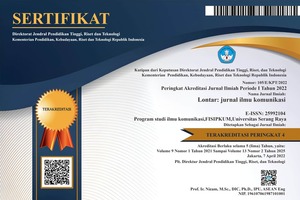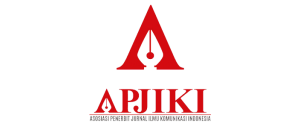Framing Human-Crocodile Conflict: A Quantitative Content Analysis on detik.com Online Media
DOI:
https://doi.org/10.30656/lontar.v13.i1.10658Keywords:
human-crocodile conflict, quantitative framing, content analysis, detik.com, online mediaAbstract
Human-crocodile conflict (HCC) is an important yet under-researched aspect of human-wildlife interactions in Indonesia with significant consequences for conservation efforts and public awareness. This study used a quantitative framing method with a content analysis approach based on 168 news articles published by detik.com in 2024 to examine how human-crocodile conflict was portrayed in this one of Indonesia's leading online media. Four variables were analyzed: news source, tone, frame type, and use of thematic versus episodic framing. The findings showed a strong reliance on government sources (79.16%), with insignificant representation of non-governmental perspectives. This resulted in narrow narrative coverage. News coverage was dominated by negative reporting, particularly in government-sourced stories (sentiment score: -0.50), perpetuating fear-based stereotypes about crocodiles. The most common frames were attribution of responsibility (34.0%) and human interest (30.1%), while thematic frames were rare (14.3%), indicating a preference for episodic and event-driven reporting over systemic analysis. These patterns suggest that the media on detik.com often reinforces sensationalism at the expense of balanced conservation messages. The study underscores the need for more inclusive, science-based reporting to foster coexistence and support effective conflict mitigation.
References
ABC News. (2025, March 17). Crocodile attacks in Indonesia are on the rise. It’s left residents on edge. https://abcnews.go.com/International/wireStory/crocodile-attacks-indonesia-rise-left-residents-edge-119860292#:~:text=In%202024%2C%20there%20were%20179,are%20also%20on%20the%20rise.
Adiprasetio, J. (2020). Under the shadow of the state: Media framing of attacks on West Papuan students on Indonesian online media. Informit. https://search.informit.org/doi/abs/10.3316/informit.569404987305786
Adiprasetio, J., & Larasati, A. W. (2021). Pandemic crisis in online media: Quantitative framing analysis on Detik.com’s coverage of Covid-19. Jurnal Ilmu Sosial Dan Ilmu Politik, 24(2), 153. https://doi.org/10.22146/jsp.56457
Adiprasetio, J., Rahmawan, D., Wibowo, K. A., Aliifa, D. N., & Hartanto, R. D. (2024). The ignorance of human cause: online news framing on floods in Indonesia. Media Practice and Education, 1–19. https://doi.org/10.1080/25741136.2024.2443864
Agustin, H., Hidayat, D. R., Supriadi, D., & Aunillah, R. (2022). The Media Verification of Hoaxes about Human-Crocodile Conflicts. Jurnal Komunikasi Ikatan Sarjana Komunikasi Indonesia, 7(1), 101–111. https://doi.org/10.25008/jkiski.v7i1.666
Agustin, R. G. (2021, April 8). Dominant voices in the time of a global disaster: Representation of science in online news reportage of the. Taylor’s FSLM Journals. https://fslmjournals.taylors.edu.my/dominant-voices-in-the-time-of-a-global-disaster-representation-of-science-in-online-news-reportage-of-the-covid-19-pandemic/
Ali, S. M. A., & Gill, D. A. (2022). Media Framing and Agenda Setting (Tone) in News Coverage of Hurricane Harvey: A Content Analysis of the New York Times, Wall Street Journal, and Houston Chronicle from 2017 to 2018. Weather Climate and Society, 14(2), 637–649. https://doi.org/10.1175/wcas-d-21-0009.1
Almiron, N., Cole, M., & Freeman, C. P. (2018). Critical animal and media studies: Communication for Nonhuman Animal Advocacy. Routledge.
Amiraslani, F., & Dragovich, D. (2021). Wildlife and Newspaper reporting in Iran: A Data Analysis approach. Animals, 11(6), 1487. https://doi.org/10.3390/ani11061487
An, S., & Gower, K. K. (2009). How do the news media frame crises? A content analysis of crisis news coverage. Public Relations Review, 35(2), 107–112. https://doi.org/10.1016/j.pubrev.2009.01.010
Apuke, O. D., & Omar, B. (2022). Media and conflict reporting: a content analysis and victims assessment of media coverage of the conflict between Farmers and Herdsmen in Nigeria. Security Journal, 35(2), 345–366. https://doi.org/10.1057/s41284-020-00280-0
Ardiantiono. (2019). Konflik manusia-buaya: bagaimana media massa memberitakannya? Kent. https://www.academia.edu/40902973/Konflik_manusia_buaya_bagaimana_media_massa_memberitakannya
Ardiantiono. (2022). MEDIA CONTENT ANALYSIS OF HUMAN-PREDATOR INTERACTION IN INDONESIA. Jurnal Belantara, 5(2). https://doi.org/10.29303/jbl.v5i2.874
Ardiantiono, N., Henkanaththegedara, S. M., Sideleau, B., Sheherazade, N., Anwar, Y., Haidir, I. A., & Amarasinghe, A. T. (2023). Integrating social and ecological information to identify high-risk areas of human-crocodile conflict in the Indonesian Archipelago. Biological Conservation, 280, 109965. https://doi.org/10.1016/j.biocon.2023.109965
Azqiya, N. V., Hadylaya, M. H., & Siregar, N. A. (2023). Analisis Isi Kecenderungan Pemberitaan Tragedi Kanjuruhan pada Portal Berita di Indonesia. Jurnal Riset Komunikasi, 6(2), 140–157. https://doi.org/10.38194/jurkom.v6i2.755
Ballejo, F., Plaza, P. I., & Lambertucci, S. A. (2021). Framing of visual content shown on popular social media may affect viewers’ attitudes to threatened species. Scientific Reports, 11(1). https://doi.org/10.1038/s41598-021-92815-7
Carlson, M. (2011). On the condition of anonymity: Unnamed Sources and the Battle for Journalism. University of Illinois Press.
CrocAttack. (2024). Annual report. https://crocattack.org/annual-report/
Dar, A., & Akhtar, S. (2023). News media framing of the environmental issues: A Transnational Comparative analysis of Pakistan and Britain. Global Digital & Print Media Review, VI(I), 17–39. https://doi.org/10.31703/gdpmr.2023(vi-i).03
Darmayulis, D. (2024). ANALISIS WACANA MEDIA TENTANG KEKERASAN TERHADAP PEREMPUAN DALAM BERITA TELEVISI. Harakat an-Nisa Jurnal Studi Gender Dan Anak, 7(1), 35–44. https://doi.org/10.30631/71.35-44
Dayer, A. A., Williams, A., Cosbar, E., & Racey, M. (2017). Blaming threatened species: media portrayal of human–wildlife conflict. Oryx, 53(2), 265–272. https://doi.org/10.1017/s0030605317000783
Detik.com. (2024a, July 30). Pria Ini Diterkam Buaya saat Mancing Ikan di Sungai, Alami Luka-Patah Tangan. Detiksumut. https://www.detik.com/sumut/berita/d-7465374/pria-ini-diterkam-buaya-saat-mancing-ikan-di-sungai-alami-luka-patah-tangan
Detik.com. (2024b, July 31). Penampakan Buaya 3 Meter yang Diduga Terkam Warga di Bangka. Detiksumut. https://www.detik.com/sumut/berita/d-7466061/penampakan-buaya-3-meter-yang-diduga-terkam-warga-di-bangka
Entman, R. M. (2009). Projections of power: Framing News, Public Opinion, and U.S. Foreign Policy. University of Chicago Press.
Gessa, S. J., Tayeebwa, W., Muwanika, V., & Rothman, J. M. (2023). Conflict or harmony: Framing of wildlife news in a biodiversity hotspot. Journalism and Media, 5(1), 1–13. https://doi.org/10.3390/journalmedia5010001
Gilboa, E. (2021). Media and conflict: framing issues, making policy, shaping opinions. BRILL.
Hanitzsch, T. (2006). Mapping Journalism Culture: A Theoretical Taxonomy and Case Studies from Indonesia. Asian Journal of Communication, 16(2), 169–186. https://doi.org/10.1080/01292980600638835
Hathaway, R. S., Bryant, A. M., Draheim, M. M., Vinod, P., Limaye, S., & Athreya, V. (2017). From fear to understanding: changes in media representations of leopard incidences after media awareness workshops in Mumbai, India. Journal of Urban Ecology, 3(1). https://doi.org/10.1093/jue/jux009
Hayes, A. F., & Krippendorff, K. (2007). Answering the call for a standard reliability measure for coding data. Communication Methods and Measures, 1(1), 77–89. https://doi.org/10.1080/19312450709336664
Indainanto, Y. I., Julianto, E. N., & Saptiyono, A. (2022). Framing Pemberitaan Kekerasan Seksual 12 Santriwati di Media Online dengan Pembigkaian Gamson dan Modigliani. Jurnal Komunikasi, 16(2), 224–239. https://doi.org/10.21107/ilkom.v16i2.15974
Ingkra, V., & Manaf, N. A. (2021). Dominant discourse in news CoVid-19 handling by the Government of West Sumatra Province. Advances in Social Science, Education and Humanities Research/Advances in Social Science, Education and Humanities Research. https://doi.org/10.2991/assehr.k.211201.043
Iyengar, S. (1994). Is anyone responsible?: How Television Frames Political Issues. University of Chicago Press.
Jabeen, I. (2024). The Portrayal of Environmental Concerns: An Ecolinguistic Analysis of Media Discourse. World Journal of English Language, 14(5), 13. https://doi.org/10.5430/wjel.v14n5p13
Jacobson, S. K., Langin, C., Carlton, J. S., & Kaid, L. L. (2011). Content analysis of newspaper coverage of the Florida Panther. Conservation Biology, 26(1), 171–179. https://doi.org/10.1111/j.1523-1739.2011.01750.x
Masduki, M., & Prastya, N. M. (2022). Perubahan Pola Kerja Jurnalistik Pasca COVID-19 dan Penurunan Kualitas Berita di Indonesia. Jurnal Ilmu Komunikasi, 19(3), 266. https://doi.org/10.31315/jik.v19i3.5058
Mayer, A., Neubauer, A. B., & Jugert, P. (2023). What is in the news today? How media‐related affect shapes adolescents’ stance towards the EU. Journal of Adolescence, 95(8), 1553–1563. https://doi.org/10.1002/jad.12225
Mokoena, Z., & Nkosi, L. (2024). Environmental Issues in South African Broadcast Media: A content analysis of coverage, framing, and source representation. Asian Journal of Media and Communication, 8(2). https://doi.org/10.20885/asjmc.vol8.iss2.art1
Nugroho, Y., Putri, D. A., & Laksmi, S. (2013). Mapping the landscape of the media industry in contemporary Indonesia. Centre for Innovation Policy and Governance.
Parahita, G. D. (2017). THE PRACTICE OF INDONESIA’S ENVIRONMENTAL REPORTERS: COMPETENCE AND CHALLENGES. Asian Journal of Media and Communication, 1(1), 1–18. https://doi.org/10.20885/asjmc.vol1.iss1.art1
Parwati, N., & Zain, A. B. N. (2020). Strategi redaksi dalam menjaga keakuratan dan kecepatan berita media online (Studi kasus di Detiknews.com Jakarta). Jurnal STMM, 5(1), 44–60.
Putnam, L. L., & Shoemaker, M. (2007). Changes in conflict framing in the news coverage of an environmental conflict. Journal of Dispute Resolution, 2007(1), 10. https://scholarship.law.missouri.edu/cgi/viewcontent.cgi?article=1527&context=jdr
Rahman, A., Agustin, H., & Mulyani, H. S. (2024). Critical Discourse Analysis of news reporting on Human-Tiger conflict in Riau Province. Jurnal Kajian Jurnalisme, 7(2), 158. https://doi.org/10.24198/jkj.v7i2.50292
Remotivi. (2023, April 13). Covid-19: Saat Ini Kita Membutuhkan Paranoia, Lebih dari Kapanpun. Remotivi. https://www.remotivi.or.id/headline/esai/578
Reuters Institute. (2024). Reuters Institute - Indonesia Report. In Reuters Institute. Reuters Institute and University of Oxford. https://reutersinstitute.politics.ox.ac.uk/digital-news-report/2024/indonesia#:~:text=Detik.com,3%25
Scheufele, D. A. (1999). Framing as a theory of media effects. Journal of Communication, 49(1), 103–122. https://doi.org/10.1111/j.1460-2466.1999.tb02784.x
Semetko, H. A., & Valkenburg, P. M. V. (2000). Framing European politics: A Content Analysis of Press and Television News. Journal of Communication, 50(2), 93–109. https://doi.org/10.1111/j.1460-2466.2000.tb02843.x
Soroka, S., & Krupnikov, Y. (2021). The Increasing Viability of Good News. Cambridge University Press. https://doi.org/10.1017/9781108982375
Tagle, F. (2025). Why Radio is More Reliable Than Television During Social Protests: An Explanation Through Framing Theory. Journal of Radio & Audio Media, 1–15. https://doi.org/10.1080/19376529.2025.2467095
Tewksbury, D. H., & Scheufele, D. A. (2009). News Framing Theory and Research. In Media Effects: Advances in Theory and Research (3rd ed., pp. 33–49). Taylor and Francis Group. https://doi.org/10.4324/9780203877111-8
Treves, A., Wallace, R. B., Naughton-Treves, L., & Morales, A. (2006). Co-Managing Human–Wildlife Conflicts: A review. Human Dimensions of Wildlife, 11(6), 383–396. https://doi.org/10.1080/10871200600984265
Valdez, R. X., Peterson, M. N., Pitts, E. A., & Delborne, J. A. (2019). International news media framing of invasive rodent eradications. Biological Invasions, 21(4), 1439–1449. https://doi.org/10.1007/s10530-018-01911-9
Van Witsen, A., & Takahashi, B. (2018). Knowledge-based journalism in science and Environmental reporting: Opportunities and obstacles. Environmental Communication, 12(6), 717–730. https://doi.org/10.1080/17524032.2018.1455723
Zapf, A., Castell, S., Morawietz, L., & Karch, A. (2016). Measuring inter-rater reliability for nominal data – which coefficients and confidence intervals are appropriate? BMC Medical Research Methodology, 16(1). https://doi.org/10.1186/s12874-016-0200-9
Downloads
Published
Issue
Section
License
Copyright (c) 2025 LONTAR: Jurnal Ilmu Komunikasi

This work is licensed under a Creative Commons Attribution 4.0 International License.
By submitting an article to the journal, the author(s) agree to transfer the published article's copyright to the journal, which will act as the publisher. This means the journal will have the right to publish the article in various forms, including reprints. The journal will maintain the publishing rights to the published articles.
In line with the license, authors and third parties (readers, researchers, and others) are allowed to share and adapt the material. In addition, the material must be given appropriate credit, provided with a link to the license, and indicated if changes were made. If authors remix, transform, or build upon the material, authors must distribute their contributions under the same license as the original.





